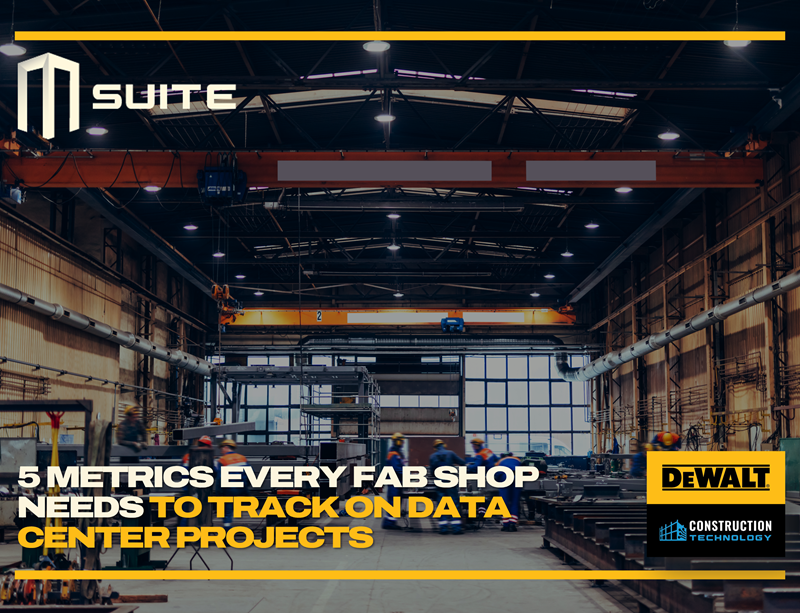For MEP fabrication leaders delivering on high-performance data centers, precision and predictability are everything. With modular builds and compressed timelines now the norm, fabrication shops must move beyond instinct and start managing operations with measurable clarity.
To stay competitive, leading fabrication managers are focusing on five key metrics that define success: throughput, labor hours, rework percentage, install rate, and material usage. These metrics not only measure performance, they drive accountability, efficiency, and profitability.
And with MSUITE’s Analytics Dashboard, MEP leaders can visualize and act on these KPIs in real time, ensuring every spool, weld, and assembly stays on track.
Why Metrics Matter for Data Center Fabrication
Data center construction has evolved into one of the most demanding environments in modern building. The combination of modular assembly, hyperscale expansion, and 24/7 commissioning schedules leaves no room for error.
Without data visibility, fabrication shops risk bottlenecks, rework, and misaligned production—all of which can derail a critical path. According to Dodge Data & Analytics, over 60% of contractors using prefabrication report faster project delivery and higher quality outcomes compared to traditional methods.
For MEP fabrication leaders, the message is clear: what gets measured gets improved. Tracking and benchmarking your key fabrication KPIs unlocks faster throughput, better labor efficiency, and higher ROI on every project.
Learn more about the power of connected workflows in MSUITE’s article:
“How Prefabrication, BIM, and Connected Workflows Are Driving Data Center Construction”
1. Throughput — The Pulse of the Fabrication Shop
Definition: The number of assemblies, spools, or modules completed per shift, day, or week.
Why It Matters:
Throughput represents your shop’s production heartbeat. In fast-paced data center projects, inconsistent throughput creates uncertainty for installation crews and logistics teams. When shop output aligns with field demand, projects flow smoothly; when it doesn’t, delays cascade.
What to Watch:
- Units completed per day or per production line.
- Performance variations by workstation or crew.
- Average time-in-process for each assembly type.
Industry Insight:
A study on Augmenting Performance of Prefabricated MEP Modular Systems via BIM Integration found that integrating BIM with fabrication workflows significantly improved production coordination and throughput.
MSUITE Advantage:
The MSUITE Analytics Dashboard gives leaders real-time visibility into production rates by station, crew, or shift. You can immediately identify bottlenecks, reallocate labor, and maintain fabrication pace with installation schedules.
2. Labor Hours — Tracking Time as a Strategic Asset
Definition: Total labor hours required to fabricate each unit, compared against planned or earned hours.
Why It Matters:
Labor is the most significant controllable cost in MEP fabrication. Overruns directly cut into project margins. For data center builds—where multiple modules are fabricated simultaneously—tracking labor efficiency per station and process allows managers to forecast accurately and avoid costly overtime.
What to Watch:
- Actual vs. planned labor hours per unit.
- Hours per linear foot or assembly.
- Labor productivity by shift or team.
Industry Insight:
The McKinsey Global Institute highlights that construction productivity has stagnated for decades, with 30% of costs often wasted in inefficiency.
Digital labor tracking and real-time reporting tools, such as MSUITE, close that gap.
MSUITE Advantage:
MSUITE ties every labor hour directly to a specific spool, weld, or job package—no manual entry or lag time. Shop managers gain instant insights into crew performance and earned-value progress. Learn more.
3. Rework Percentage — The Hidden Margin Killer
Definition: The percentage of total work hours or assemblies spent correcting non-conforming or defective work.
Why It Matters:
Rework burns both time and money. For data centers, where systems must integrate flawlessly, even minor errors in fabrication can create schedule chaos downstream. Reducing rework is the fastest way to increase profitability and maintain quality standards.
What to Watch:
- Rework incidents per 100 units or spools.
- Hours or dollars lost to rework.
- Root causes (design errors, shop errors, material defects).
Industry Insight:
A Geometric Quality Inspection of Prefabricated MEP Modules study on ScienceDirect demonstrates how 3D scanning and digital QA reduce rework and material waste by detecting deviations early. Read full study
MSUITE Advantage:
MSUITE lets shops log and tag rework events with cause, cost, and responsible workflow. The Analytics Dashboard correlates this data to specific jobs, enabling proactive fixes before mistakes multiply.
4. Install Rate — Bridging Fab and Field Performance
Definition: The speed at which fabricated components are installed on-site (units per shift or per crew).
Why It Matters:
Fabrication success doesn’t end in the shop—it ends with installation. If production outpaces field capacity, backlogs form. If field crews can’t install as fast as fabrication delivers, the entire supply chain suffers.
Industry Insight:
According to Equinix, modular data centers rely on synchronized delivery between fabrication and installation to maintain continuous build momentum. Aligning the install rate with the throughput ensures just-in-time flow.
MSUITE Advantage:
MSUITE’s connected platform unites fabrication and field data. Shop and field leaders see the same install metrics, making it easier to adjust production pace, logistics, and workforce to match field realities.
5. Material Usage — Turning Waste into Opportunity
Definition: The ratio of material used in final assemblies versus total purchased material (yield rate).
Why It Matters:
Material waste silently drains profitability. In large-scale data center projects, even a 2% reduction in material waste can save hundreds of thousands of dollars. Tracking material yield provides actionable insight for procurement, planning, and process optimization.
Industry Insight:
A Review of Module Division Methods for MEP Modular Construction shows that efficient material segmentation and prefabrication planning improve yield and reduce site waste.
MSUITE Advantage:
MSUITE’s dashboard integrates material data from nesting software and purchase orders. Leaders can monitor material yield and scrap rates by job or machine, ensuring maximum resource utilization—more information.
Transforming Metrics into Action: MSUITE Analytics Dashboard
Tracking KPIs is good. Acting on them in real time is better. The MSUITE Analytics Dashboard empowers fabrication managers to make faster, data-backed decisions that drive performance and profitability.
1. Unified Real-Time Visibility
Monitor key performance indicators, including throughput, labor hours, rework, install rate, and material usage, from a single live dashboard.
2. Drill-Down Insights
Go from high-level KPIs to crew or station-level views. Quickly identify where performance is improving—or slipping.
3. Cross-Project Benchmarking
Compare productivity across multiple data center builds. Identify high-performing workflows and replicate success.
4. Predictive Alerts
Set thresholds (e.g., rework > 5%) and receive instant alerts when metrics exceed these thresholds.
5. Shop-to-Field Coordination
Align fabrication output with site installation pace for accurate just-in-time delivery. Learn how analytics can elevate your shop’s performance.
Proof from Industry Leaders
MEP fabricators using MSUITE report:
- 40% boost in productivity through better coordination and data visibility.
- A 74% reduction in spool sheet creation time is achieved through automated workflow feedback.
- Significant rework reduction via connected QA tracking.
See how fabrication leaders are transforming performance.
The Bigger Picture: Data Centers and Prefabrication
Global demand for data centers is growing at record speed. Omdia Research reports that AI workloads are driving accelerated adoption of prefabricated and modular data centers across the U.S. and Europe. Full article
MEP leaders must respond by scaling smart—using digital tools and measurable KPIs to ensure consistency, speed, and quality. Prefabrication, BIM, and connected workflows are the proven pathway.
Dive deeper into how technology is transforming data center construction in MSUITE’s article:
Building a Metrics-Driven Fabrication Culture
Adopting KPI tracking isn’t about micromanagement—it’s about empowerment. Here’s a simple roadmap for MEP fabrication leaders:
- Baseline Your Current Performance: Document throughput, labor, and rework rates.
- Automate Data Capture: Replace manual logs with MSUITE’s real-time metrics.
- Set SMART Goals: Define measurable targets for each KPI.
- Review Weekly: Hold visual KPI meetings to reinforce accountability.
- Continuously Improve: Utilize trend data to inform training, process enhancements, and ROI optimization.
With tools like MSUITE Analytics, your fab shop transforms from reactive to predictive—delivering with certainty on every data center project.
Final Thoughts
For today’s MEP fabrication leaders, performance is measured in metrics—not guesswork. By tracking key performance indicators such as throughput, labor hours, rework, install rate, and material usage, you gain the visibility and control needed to outperform on every data center build.
MSUITE’s Analytics Dashboard gives you that control by centralizing KPIs, eliminating data silos, and transforming raw numbers into operational excellence.
To learn how MSUITE can help your team achieve measurable improvement across fabrication and field performance. Schedule a call.









